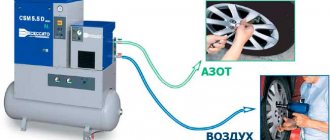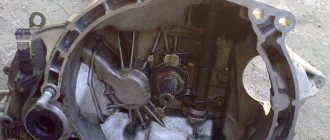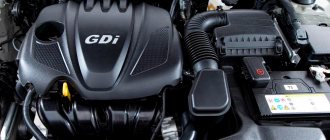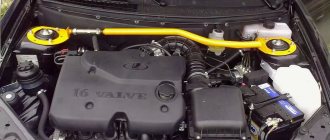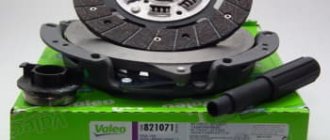November 13, 2019 Lada.Online 29 528 6
In the fall, AVTOVAZ presented the updated Lada Vesta. Now this family is equipped with a Renault-Nissan alliance engine (1.6 l, 113 hp) and a continuously variable automatic transmission JF015E (hereinafter referred to as “variator” or CVT). We managed to find out how the car turned out during the test drive.
What transmissions are installed on the Lada Vesta?
Until recently, the manufacturer installed a conventional “robotic” manual transmission on the car, which has one clutch.
The use of such a transmission complicated the process of driving the car several times; the gearbox took a long time to switch, and the car could stop while driving. Therefore, over time, the Lada Vesta was improved with a new stepless variator.
The Jatco JF015e transmission is a development of a Japanese concern. It is a continuously variable hybrid of a classic automatic transmission, which is complemented by a two-stage CVT.
Due to the fact that the box has 2 planetary-type gears, it became possible to reduce the size of the cones, their weight and the general parameters of the transmission.
This design has the following technical features:
- transmission type – classic with 7 gears, designated CVT-7;
- machine torque – up to 160-165 Nm;
- subject to maintenance (oil and filter replacement) every 35-40 thousand kilometers;
- lubricant volume – 7.2 l;
- the estimated resource is 160 thousand km.
As an alternative to this variator, the AMT robot can be used, which has only one clutch and is based on a VAZ-2181 manual gearbox with 5 steps.
Prices
The version with a CVT will be 50 thousand more expensive than the version with a VAZ-21179 engine and manual transmission. With the launch of the CVT version, all trim levels have been updated:
- The most affordable version is the 1.6 sedan (113 hp), AT Jatco, Classic + Start Plus - 736,900 rubles.
- The maximum cost for Lada Vesta SW Cross 1.6 (113 hp), AT Jatco, Luxe + Prestige is 982,900 rubles.
Design and principle of operation of the variator
The CVT transmission is equipped with virtual gears that are created at the program level.
The Lada Vesta transmission uses a V-belt drive, a gearbox with two stages and gears, and a torque converter. The transmission is formed by two pulleys, which are connected to each other by a V-shaped belt.
After the gear ratio is formed, it goes to the driven pulley, which is connected to the wheels and drives.
The operating principle of the variator is as follows:
- When movement begins, the cones of the driving pulleys are separated and the driven pulleys are connected. In this situation, the motor has a minimum load.
- When the speed increases, the reverse process occurs. As a result, the gear ratio decreases, which has a beneficial effect on reducing traction. In this case, the displacement of the pulleys occurs as a result of the action of springs and an increase in centrifugal force.
The variator device is represented by a mechanism responsible for transmitting torque and disconnecting the gearbox from the engine, the variator itself, a structure designed for reversing, and a control system.
The main distinguishing feature of the variator from other gearboxes is the smooth adjustment of torque within the established range.
The main structural elements of the design are pressure-reducing valves, solenoids, a hydraulic unit, a slider, a belt, a torque driver and its working elements, a bushing, a roller, etc. The hydraulic unit performs one of the main tasks - the smoothest possible transmission of force, without any stops or jerks . That is why the service life of the variator increases.
Ways to save fuel
The continuously variable transmission of the Japanese brand Jatco is widely used on cars of the Renault-Nissan Alliance, and from July 2022 it is offered to customers on the LADA XRAY Cross. The main feature of the automatic transmission is that, in addition to a V-belt drive with a powerful steel belt, there is a two-stage gear sector. This solution made it possible to make the unit more compact and 13% lighter than previous models. This design increases traction characteristics and at the same time is not afraid of frost, slipping and heavy loads, and, in addition, with confident acceleration it provides high acoustic comfort and fuel efficiency.
Service life of the variator on Lada Vesta
The resource of the variator installed on the Lada Vesta is almost identical to this indicator inherent in the Nissan Juke, and is approximately 100 thousand km. But in order to keep this indicator normal or to achieve its increase, you should be careful about the maintenance of the part and its periodic diagnostics.
The most important thing is to promptly replace the lubricating fluid in the structure.
Car service employees recommend carrying out this procedure at least once every 45 thousand km of distance traveled. But according to the information indicated in the technical documentation, this replacement is recommended to be carried out only after traveling 120 thousand km.
The main condition is that the procedure must be complete, that is, it is necessary to carry out 3 replacements, replace the fine filter devices and rinse the coarse filter.
Also, do not forget about particles and debris that can stick to the two magnets in the tray. Another point is the liquid that is recommended for use - NS-2, NS-3.
Well, don’t forget about careful operation of the car and all its working components. To do this, you should not accelerate at the start, do not skid for a long time on areas with uneven surfaces, in mud, and in the summer heat, try not to load the variator.
Main technical characteristics - Technical problems
To install the rear wheels, the plant used a semi-independent torsion beam equipped with shock absorbers and coil springs with nonlinear stiffness. The introduction into the manufacturing process of internal combustion engine components of a complex of technological operations, including increasing the class of mechanical surface treatment, and the use of structural materials made it possible to increase the efficiency of the unit by reducing the friction of the working surfaces in the connecting rod and piston group.
| 1.6 l 16-cl (106 hp) 5 manual transmission | 1.8 l 16-cl (122 hp) 5 manual transmission | 1.8 l 16-cl (122 hp) 5AMT | |
| Urban cycle, l/100km | 9,7 | 10,7 | 10,1 |
| Extra-urban cycle, l/100km | 6 | 6,4 | 6,3 |
| Mixed cycle, l/100km | 7,5 | 7,9 | 7,7 |
Positive features of the Jatco variator
Many drivers are wondering which car is better to take, with an automatic transmission or a manual transmission? Unlike a hydromechanical gearbox, movement on a robot, which begins without preheating the engine at low temperatures, is smoother and more even, which has a positive effect on the operation of the transmission.
The second advantage of such an AMT compared to a traditional box is considered to be efficiency.
Such a transmission has several other advantages, the main ones of which are the affordable price, a wide variety of analog spare parts, as well as a detailed study of the design and working components of the mechanism.
The CVT really deserves a lot of praise compared to other well-known transmission options. The reason for this is a large number of justifications:
- smooth gear ratio switching, which has a beneficial effect on driving dynamics when starting or quickly accelerating;
- economical consumption of fuel mixture;
- smooth and even ride;
- no minimum speed even on sharp climbs;
- ease of maintenance due to its low weight and simple design compared to a standard automatic transmission.
Also, when changing the gear ratio, the driver will not notice unpleasant sounds in the engine operation, which usually occur with other types of transmissions.
The car owner can independently adjust the variator in order to ensure engine speed at a minimum level. As a result, the engine will operate virtually silently.
And due to the fact that the design uses a two-stage planetary gearbox, it reduces the resistance value during the process of mixing transmission oil. And this, in turn, has a beneficial effect on its performance at low temperatures, when this liquid usually thickens.
Problems of automatic transmission for the Russian new product Technical characteristics
| Which Lada Vesta to choose - with a manual transmission or a variator The introduction into the manufacturing process of internal combustion engine components of a complex of technological operations, including an increase in the class of mechanical surface treatment, and the use of structural materials made it possible to increase the efficiency of the unit by reducing the friction of the working surfaces in the connecting rod and piston group. The HR16DE engine, otherwise H4M, uses fuel injectors of a new design, the latest generation spark plugs and an electronic throttle valve; the fluid coupling device has also undergone design changes in order to increase reliability. |
- a creeping mode has appeared, in which the car starts moving without using the gas pedal;
- speed is gained without jerks or dips in traction;
- clear switching of forward and backward driving modes.
Disadvantages of the variator
In addition to the positive aspects, the variator also has negative ones:
- low strength of parts;
- the need for constant replacement of transmission fluid and filters;
- the appearance of extraneous sounds during bearing operation;
- Regular malfunctions of the planetary gear are observed.
This type of transmission also has its disadvantages, the main one of which is the specific nature of the movement. That is, on the Lada Vesta it is better to avoid slipping, rapid acceleration or sharp pressing of the brakes, as the unit can quickly fail due to accelerated wear.
It is also not recommended to drive a car with a trailer or tow another car. This is due to the fact that such driving significantly increases the load on the gearbox, increasing its wear.
Lada Vesta cars are suitable for transmissions that still have many shortcomings, but only one of them has been eliminated - a roller bearing is fixed to the input shaft.
Tuning N4M
An affordable option to tune the H4M engine is to do chip tuning , changing the standard indicators upward. This method, judging by the reviews, will not give a noticeable gain and sensations that the car enthusiast expects from this procedure.
If you want to really increase power, you need a 4-2-1 spider exhaust manifold and forward flow on a two-inch exhaust pipe . By adding to this a cold air intake and chipping of the internal combustion engine computer, it is possible to achieve power figures of 125 horses .
But the real result is achieved by installing a turbine . For example, a small option for a standard piston: “VW K03” with an intercooler and pipe kit , a corresponding manifold , high-performance injectors and direct-flow exhaust. Moving in this direction, it is possible to achieve power of 160 and even 200 hp.
How to check the variator for malfunctions?
A transmission that is in good condition and idling should not make any noise for the driver to hear the engine running. If there are extraneous noises, then the box needs servicing. This is considered the easiest way to quickly diagnose the performance of the device.
Testing the variator while driving is considered the most informative. The operation of the structure should not be accompanied by jerks when moving from a standstill. The move in this case should be smooth and even. In the future, there should also be no jerking observed during the distance, which may indicate that the belt is jamming.
To check whether the variator has been disassembled before, you need to pay attention to the condition of the bolts and fasteners. The presence of abrasions, scratches, and snags indicates that the transmission has previously been serviced with working tools. But this fact does not mean that there may be any problems with it. The main thing is to pay attention to this and ask the seller what faults have been corrected.
Don’t forget to check the level and condition of the transmission oil.
For this, a special probe is used, which is lowered into a container with liquid. The test is carried out in two states, when the oil is cold and heated, to determine its viscosity and ability to wash the working components of the variator.
H4M Service
Having earned positive marks for its practicality , low fuel consumption and compliance with all environmental standards , the N4M engine turned out to be quite unpretentious in maintenance.
- According to the manufacturer, the timing chain mechanism has an unlimited resource ; if the chain breaks, it does not bend the valve , although in practice replacement is desirable after a run of 150 thousand km.



